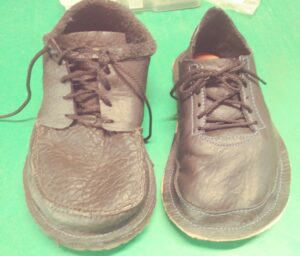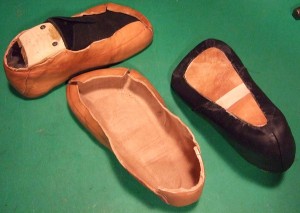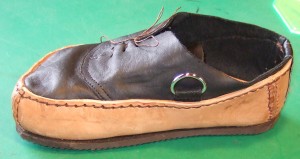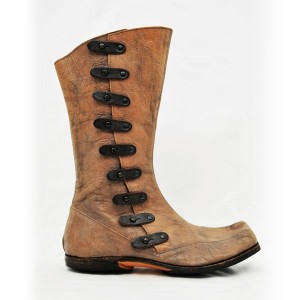I’m making shoes again.
I bought a pattern and did a test-build. The upside, I learned a lot. I’m totally unsurprised the result doesn’t fit. My feet are pretty abnormal.
 It’s important to know what type of foot you have. I have very short feet with very high volume and my foot has a significant curve from heel center to toe center. My foot from heel to end of middle toe is 8.25″ long. My foot is also very wide. 3FF. Until I had custom boots made at White’s I didn’t know there was such a size. Wadly, venerable spouse, says I wear boxes with laces. Wadly has feet that are the complete opposite. His are very long, very narrow and extremely low volume. He’s living the other end of the “shoes don’t fit” spectrum, he has skis for feet.
It’s important to know what type of foot you have. I have very short feet with very high volume and my foot has a significant curve from heel center to toe center. My foot from heel to end of middle toe is 8.25″ long. My foot is also very wide. 3FF. Until I had custom boots made at White’s I didn’t know there was such a size. Wadly, venerable spouse, says I wear boxes with laces. Wadly has feet that are the complete opposite. His are very long, very narrow and extremely low volume. He’s living the other end of the “shoes don’t fit” spectrum, he has skis for feet.
 The shoe pattern I bought is designed for a more common lower volume straighter foot, something approaching the average foot shape.
The shoe pattern I bought is designed for a more common lower volume straighter foot, something approaching the average foot shape.
These are from two different pairs of shoes, one I designed that fits and the pattern result. The shoe on the left is what fits me. It is loose enough to accommodate a heavy sock. The shoe on the right is from the pattern. I haven’t added a sole yet because the shoe so low volume I can’t wear it with a sock. I have to take it apart and rework it into something with enough volume to accommodate a sock. (See epiphany at end)
 Feet come in four toe shapes; sloped, mountain, plateau and square. This shoe pattern is designed for someone with sloped toes with the big toe being the longest. I have mountain shaped toes with the middle toe being the longest. I had to take some off the big toe and redistribute that volume to the middle toe before ever trying the test shoe. There isn’t quite enough height to comfortably accommodate my fat little piggy toes, something another pattern user commented on.
Feet come in four toe shapes; sloped, mountain, plateau and square. This shoe pattern is designed for someone with sloped toes with the big toe being the longest. I have mountain shaped toes with the middle toe being the longest. I had to take some off the big toe and redistribute that volume to the middle toe before ever trying the test shoe. There isn’t quite enough height to comfortably accommodate my fat little piggy toes, something another pattern user commented on.
The second issue is the shape of my foot versus the shape of the footbed. My feet aren’t straight. They curve from heel to toe. If my feet were straight I’d probably wear a women’s 6C or D. The left is a tracing of my foot with room for my toes. This is the shape and size of the foot bed that works for me. The right is my foot bed laid over the pattern sole. Parts of my foot go right over the flange and, at one point, out of the pattern. There’s no way the pattern’s footbed’s shape will ever accommodate my foot.
The poor fit is NOT the fault of the pattern. For most people this would be a lovely pattern with a nice unique heel construction. I know my feet are weird and expected no less than a bad fit when someone else drafts the pattern for the average foot.
The pattern video is here and partners the pattern. It’s worth a watch if you’re at all interested in making your own barefoot shoes. The video sound isn’t the best so be prepared to turn it up.
In writing this I had an epiphany. I spend 99% of my time barefoot. I have fake crocs I use for running to the outside fridge or out to meet delivery drivers when they show up when the weather is wet or cold. I can take these “do not fit”s, fold the heel down and turn them into a replacement without too much effort. If I rip the midsole off and replace it with the shape that fits me I will end up with new slipons that will work for that job handily. A new midsole, a bit of sewing and soling, new elastic laces and I’ll be all set. Win win!

 One of the activities I miss is cordwaining (shoe making). I see shoes I’d love to wear (bear in mind, I wear a mens 3FF, not a size that is commercially available) and think . . . I could make those! Today, on Pinterest, I ran into these beauties.
One of the activities I miss is cordwaining (shoe making). I see shoes I’d love to wear (bear in mind, I wear a mens 3FF, not a size that is commercially available) and think . . . I could make those! Today, on Pinterest, I ran into these beauties.

































